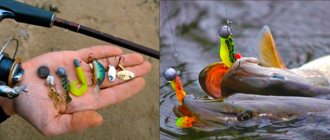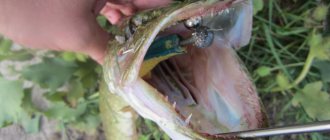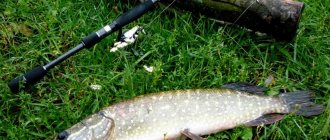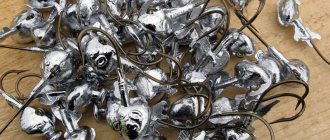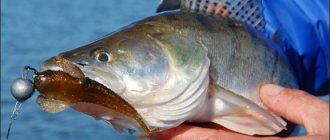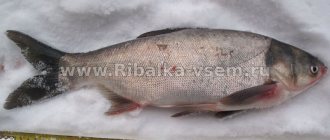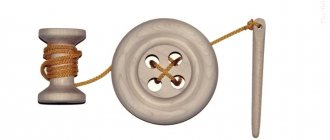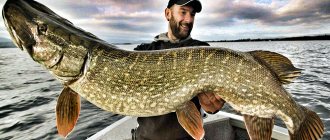Ice fishing for pike with a jig in winter (the ancestor of which is the well-known jig), unfortunately, has not yet become particularly widespread. However, having a supply of artificial silicone baits that are actively used in the warm season, why not try them in ice fishing? Practice shows that catching pike with a jig in winter from ice is no less interesting than fishing in warm weather. Moreover, this method will be interesting for both beginner winter fishermen and experienced fishermen.
Winter jig from ice. Pike
In order for pike fishing to be successful, you need to know the behavioral characteristics of the main predator of freshwater bodies. At the very beginning of winter, when the fish are still very active, it is better to ice fish closer to the shore. It is here that small fish gather, which the pike feeds on. It is also necessary to stay close to the shore for safety reasons, since the ice is still thin. As a rule, pike hunting during this period is the most effective with jigs and other types of bait. After the ice hardens, the predator remains active for some time, and then becomes slower and more picky about the bait.
The best pike fishing is with a jig in winter in calm, cloudy weather. There are very good bites when it snows. The worst bite is on frosty sunny days.
Sometimes pike completely ignore any bait. The fish becomes more active towards the end of February, as it prepares for spawning and the “zhoring” begins. Here, as they say, “fisherman, don’t yawn!”
Fishing places
Catching large pike with a jig should be carried out taking into account the specifics of the reservoir and its features. Depending on the type of reservoir, the following locations of the predator are distinguished:
- In rivers of medium and large size, pike can easily be found in channel depressions, on dumps, areas with snags and other areas, the topography of which is characterized by uneven depth.
- When visiting reservoirs, you need to pay attention to areas with great depth, as well as locations where there are flooded stumps, branches, and logs. In such reservoirs, pike can be found in the riverbed, on dumps, near the edges, in branches and tributaries feeding the reservoir (provided there is sufficient current and depth for jig fishing).
- On lakes and flooded quarries, pike can also be found at great depths, when exiting a hole, on sharp edges near the shore, on mounds and other unusual places. It is on them that the predator arranges its ambushes and waits for prey.

If we are talking about small rivers, then the use of microjig is justified. There will be a lot of small fish biting, but the fishing dynamics will definitely please the novice fisherman.
Tackle
In essence, the gear for ice fishing in winter is not much different from summer: small rigs, soft silicone bait. The diameter of the fishing line for pike or pike perch ranges from 0.3 to 0.35 mm. When fishing for pike, a prerequisite is the use of a soft steel leash. It will help protect the tackle from pike teeth. The next steps are as follows.
- tie the jig head to the end of the fishing line;
- A silicone bait is attached to the hook. Choose it so that it matches the hook number.
About
Equipment for catching pike perch
Jig rig
The sinker on the eye and the hook on which the bait is placed are connected through a winding ring or carabiner.
Texas rig

It is a bullet-shaped sinker with a longitudinal axial hole, put on a separate piece of fishing line along with a hook and a bead separated from it. A silicone bait is threaded onto the hook.
Effective in places where there are many obstacles to wiring. An offset hook is used to increase the permeability of the equipment.
Carolina rig
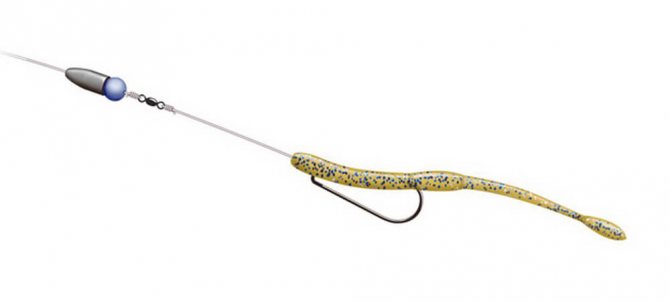
It differs from the Texas one in that the sinker and bead are on the same piece of fishing line, and a hook with bait is attached to them through a carbine on a separate leash.
Retractable leash or Moscow equipment
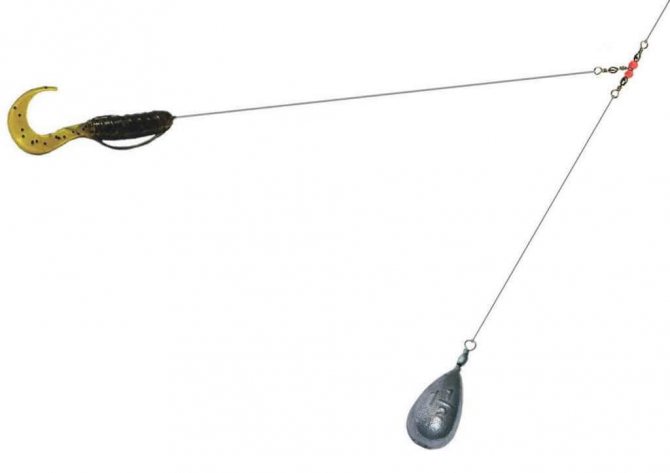
It consists of two different pieces of fishing line connected on a T-shaped swivel. A sinker is attached to one end of a piece of fishing line, and a hook with bait is attached to the other leash. At the third end of the swivel, the equipment is fastened through a carabiner to the spinning cord.
Drop shot
A sinker is tied to the end of the fishing line, a hook with bait is tied in the middle of the section of fishing line, and at the end there is a swivel for attaching to the main cord. Since this tackle is not intended for guiding, it will be effective on the edge of riffles and holes.
Winter jig technique from ice
After the tackle is prepared, drill a hole and begin fishing the bottom layer with a jig head with silicone bait. If the bottom is silted or there are no bites, they resort to tricks, slightly modifying the tackle, changing baits and animation techniques.
The bait is twitched up and down, causing it to play. Here are some options for playing when fishing from ice:
- Lower the bait to the bottom and move it there.
- Raise the jig bait in steps of 200-300 mm (for pike this is the most acceptable option), take a short pause and release, and repeat this cyclically.
- “Tossing” with small jolts, which forces the silicone to move (as far as possible) in the horizontal plane.
If fishing with an ice jig is done in still water, then the angler is limited in his actions due to the small size of the hole. If there is a current, then he fishes a larger area due to the fact that the gear is carried some distance. However, there is no need to go to extremes. If the tackle is carried far from the hole, you may miss the bite.
Another option to make vertical fishing a little more varied is to drill a hole above the underwater slope and then “jump” down its ledges.
Edible food during winter fishing
Date: January 10, 2021 | 021
Since it’s not winter yet, it’s worth mentioning one very interesting question: do silicone baits, edibles, work when fishing in winter from ice? Indeed, since one of the main topics of this blog is silicone lures, it’s a good idea to figure out whether they are relevant only in open water for spinning fishing. Or there is an opportunity to successfully catch fish on them all year round, including in winter, from ice, from holes. In this review I will share my thoughts on this topic.
Predatory fish, at least our main freshwater predators, are active in winter. Perch is almost the main winter fish in most of our freshwater bodies. In winter, at times, both pike and pike perch are caught well. Asp, chub, etc. It is very difficult to catch white predators from the ice and this happens rarely. But the burbot turns on. The catfish has been turned off since the onset of the autumn cold snap (if only in places where thermal power plants are discharged, but there is no ice there either...). So, there is someone to catch.
And, if we successfully catch perch, pike and pike perch from the ice using jigs, winter lures, balance beams, etc., why not try fishing with silicone baits and modern edibles. And nothing interferes! Moreover, fish are being caught. The only problem so far is that very few people practice this kind of fishing. There are few experimenters who are ready to challenge the traditional set of winter artificial baits and begin mastering winter fishing with silicone . Well, in order for things to move more actively, let’s look at the features, problems and opportunities faced by a winter fisherman who is planning to pamper a winter predator with some food.
In fact, in the summer we fish with an ultra-delicate spinning rod, a nanojig. They use thin fishing lines, the lightest installations, 90% of which are presented in the form of jigs, weighing up to 1g. We use miniature silicone baits or homemade edible silicone baits. What is stopping us from adapting the same equipment to a winter fishing rod and fishing through the hole, from the ice, using mainly the vertical component of the game. Yes, nothing interferes! And if you are fishing for pike or pike perch, then it is quite possible to fish with larger silicone baits, 2” and 2.5” in size, and maybe even larger.
The simplest version of fishing gear for edibles in winter will look like this. Essentially, this is a winter jig rig for vertical fishing. And now I’ll briefly tell you how to do it. An ordinary light, short winter fishing rod with a reel or reel. Thin fishing line, as we usually use in winter. If for perch, then 0.06-0.08mm, if for pike or pike perch, then 0.12-0.14mm. To the end of the fishing line we tie a jig or a gram eared fish with a small single hook. We attach an inch twister or some other silicone of comparable size to the hook. That's all. We drill a hole, fish the bottom layer, sometimes tearing the bait from it, sometimes trampling along the very bottom.
Yes, if we are talking about targeted hunting for winter pike, you should limit yourself to one bait. Take something larger for this quality, 2.5”, 3”, maybe even more. I prefer narrow-bodied edible vibrotails. And, of course, place a small leash made of the finest steel in front of the bait.
If the bottom is heavily silted, or the fish does not take from the very bottom, then it makes sense to look for it a little higher. To do this, we will make a tackle that essentially resembles a drop shot. At the end of the line we tie a weight, usually a little heavier than we would use just for jigging. And above, 30-50cm from the sinker, there is a hook. And on the hook we put the same miniature silicone, or a cut of edible food.
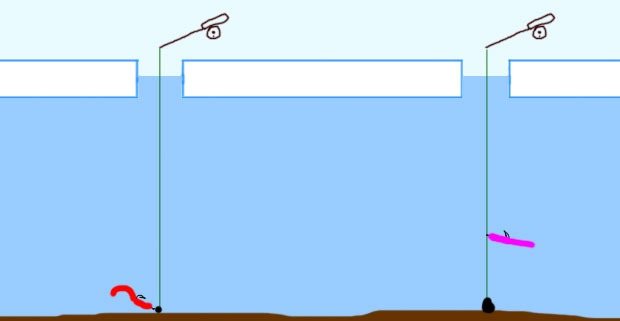
And with these two simple, and, in principle, obvious installations, you can successfully catch predatory fish in winter, from holes, using silicone baits.
By the way, about the aforementioned delicate winter drop shot. You can tie not one hook, but 2-3. And fish with different baits in different layers of water. You can tie the hooks directly to the fishing line, or you can form short leashes to give the bait more liveliness. This, it turns out, is already a garland. Only in the summer we drag it along the bottom, but here we work in a vertical plane. In fact, this is a tyrant, well known to those who fish in the sea. In particular, fish such as smelt are caught using this kind of tyrant, only pieces of colored gum (cut condoms...) or colored threads are used as bait. So, what we will use for our traditional predators is just a slightly larger version of the long-known rigs.
There are several options for tying such leashes. The first and simplest. We string 2-3 hooks onto the fishing line. Stings towards the end of the line. We grab the ring of each hook with a single knot. We form a short leash and secure it with a double knot. This leash made of double fishing line has a length of 3-6 cm.
The second option is to simply tie a short leash with a hook to the main fishing line. You can simply splice it with a knot or connect it in a loop-to-loop manner.
Which lures from the wide variety of silicone are relevant to use in winter, when ice fishing. Small twisters and vibrating tails work well. The tails of these active baits work both on the rise and on the fall. The size of such baits greatly depends on the size of the fish and its behavior. If you catch small and medium-sized perch, then use baits of 1”, 1.5”, 2”. And if they catch pike perch, pike, or catch a large perch, then larger tires are used.
In addition to twisters and vibrotails, you can use slugs, crayfish, and silicone worms. Those. full set.
Since small-sized baits (1-1.5”) are not so common, cutting is often used. We simply take a sharp knife or blade and cut narrow strips from large edibles (worms, slugs, vibrotails). This is how you get homemade silicone worms or slugs. By holding and playing with these baits using short pulsating movements in the vertical plane, they provoke the fish to attack.
In addition to classic edibles and slicing, in winter it is important to use silicone imitations of bloodworms, maggots, and various nymphs. Also, there are baits such as caviar made from edible silicone. And this is also worth trying to catch.

Since frost has a bad effect on silicone and can freeze it with an icy crust at the slightest exposure to air, you should be careful about this point. Keep packs of edibles and slices warm, in your breast pocket. And the baits that are in use must be warmed up and the ice crust removed if it has managed to form during the process of manipulating the tackle.
There is one point that is also worth pointing out. Edible silicone works in winter, alas, mainly after the bite, when the bait is already in the mouth of the fish. The fact is that in cold water attractant particles spread extremely poorly when compared with warm water in the summer. This comes from the characteristics of the diffusion process. Microparticles mix more actively as the temperature of the medium increases. So, the factor of attracting fish from a distance by the smell of bait is almost completely neutralized. But when the fish grabs, its receptors sense the attractive composition of the attractant and the presence of salts. And the fish tries to hold on and swallow such bait more actively. Hence the conclusion that it is better to use a full-fledged edible product in winter, or cut from it, than regular silicone, or simply anointed with an attractant. So, when ice fishing, I would advise using edible silicone from leading Japanese brands, saturated with both attractant and salts.
Fishing in winter, in holes, with a slight current may be more interesting. If fishing takes place in still water, then the angler is very limited and can only fish a small area of the bottom, which is directly under the hole. If there is a current, then it becomes possible, by changing the weight of the weight and manipulating the swings of the fishing rod, to fish a certain strip along which the current carries the tackle.

Also, you can diversify your fishing if you drill directly above a fairly steep drop or edge. Then you can fish some area with variable depth, jumping along the slope.
Thus, you can try fishing in winter, from holes, with our usual summer silicone baits! I do not urge all winter travelers to urgently abandon their usual winter spinners and balancers and switch to silicone fishing. No! But, at a minimum, diversify and experiment. Periodically trying to fish in winter with such baits is very worth it. At least put edible fish on the hooks of classic winter baits and combine them.
Share with your friends:
Categories: Fishing for food · Tags: Winter, Places, Perch, Lures, Pike-perch, Edible, Equipment, Pike
Winter jig heads
For ice fishing, you can use jig heads of any shape: from classic spherical ones to the most exotic ones: “bananas” and “horseshoes”. It's just a matter of availability. However, given that fishing is carried out in a vertical plane, heads with a wider amplitude of play will work better. The same oscillating and swinging jigs or modified ones with a disk.
About
Spinning rod for catching pike perch on a jig

When hunting for pike perch, use a rod of at least 2.4 meters. The fanged fish bite often occurs in the coastal zone.
Using a long rod allows you to perform a jerk retrieve more effectively. For fishing from the shore, a spinning rod 2.7-3 meters long is recommended.
Expert opinion
Vladimir Poltoranin
Fisherman - expert
The blank should be hard and fast, obeying even slight force with the brush. Build fast and super fast. The test ranges from 4-60 grams.
The choice of test depends on the nature of the reservoir in which you plan to fish. Today there are forms on sale with a wide range of tests that are suitable for catching pike perch in different conditions.
Lures
The main feature of ice jigging, which differs from summer fishing, is that the bait works only in the vertical plane. Fishing with balancers and winter lures has been well studied, so many anglers are often cautious, preferring familiar gear rather than jigs. Therefore, let's look at this in more detail.
Silicone bait has these advantages.
- low cost;
- high level of catchability;
- possibility of self-production.
The disadvantage of a silicone jig is its short service life. Predatory fish, including pike, spoil the bait, sometimes simply biting it. Many silicone baits “dull” in the cold and lose their ability to play. Therefore, for ice fishing, devices made of soft jelly-like silicone are used.
The winter predator is a demanding and capricious client, paying attention only to attractive edible bait. Often, in order for the bait to play better, a 2-3-centimeter polyvinyl chloride disk is attached to it, which swings the bait, leading it to the side (you could see its version in the video posted just above in the article). The ideal option is when the bait creates the impression of a small fish that moves near the bottom with periodic additives.
Silicone slugs
A good result is obtained with slug baits, which outwardly resemble fish feeding in the bottom part of a reservoir. Small vibrating tails can be used for the same purposes. The pike actively reacts to the vibrations created by this bait and attacks it.
About
